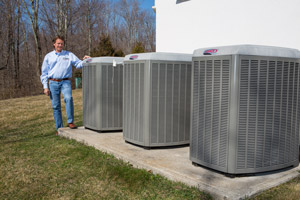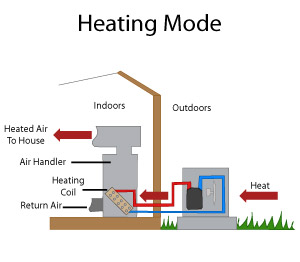The 3 Types of Home Heat Pumps and How They Work
What is a Heat Pump?

As the name suggests a heat pump "pumps" heat from one location to another. Most are equipped with reversing valves that enable them to provide both heating and cooling.
A heat pump is one of the most energy-efficient ways to heat and cool a home, especially those in climates with moderate heating and cooling needs. Whether you’re renovating and considering a new heating system, your old furnace is ready to be replaced or you want to improve your home’s energy efficiency, this overview of the three major types of heat pumps and how they work will help get you started.
A heat pump works a lot like a refrigerator or air conditioner: it uses electricity and a refrigerant to “pump” or move heat from one location to another. It does not generate heat the way a furnace does. Instead, it takes advantage of the energy that can be found in the air, ground, and water sources surrounding your home.
Even in the coldest months, this heat energy is still present and the heat pump extracts and transfers this heat into your home. The same principles apply when it’s warm outside, but in reverse; the heat pump removes the heat from your home and relocates it outside, providing an air conditioning function.
Compared to operating conventional home heating and cooling appliances, heat pumps can often condition a space at a fraction of the cost. That’s why heat pumps are considered one of the most energy-efficient home heating and cooling methods to condition your entire home, or even just one part of your home, all year long.
Types of Heat Pumps

A diagram of how a typical heat pump operates: extracting the heat from outside and relocating it into the home.
There are three main types of heat pumps: air source, water source and ground source (geothermal). All three of these operate on the same principles mentioned above, except they all gather heat from different sources.
1. Air Source Heat Pump
Air source, also known as an air-to-air pump, extracts heat from outdoor air and transfers it into your home. This is one of the easiest and cheapest heat pumps to install and takes up little space. Ductless heat pumps are energy efficient compared to other ground and water sourced methods in mild climates and less efficient, in very cold climates, than a ground source pump with a well-designed ground loop. The Department of Energy estimates that an air-sourced heat pump can help reduce energy by 50%.
2. Ground Source Heat Pump
A ground source heat pump, also known as a geothermal heat pump, extracts the heat energy from the ground and soil around your foundation and transfers it into your home. The ground temperature is almost always warmer than the air in the winter, which is why ground source heat pumps are more efficient than air source heat pumps, especially in the winter months.
A geothermal heat pump is also more reliable and quieter than an air source system. The main reason geothermal heat pumps haven’t become more widespread is due to the high cost of installation. For the system to work correctly, excavation is needed to insert long runs of plastic tubing underneath the home. A newer system called “direct-injection” aims to make this process more affordable, but still requires more time, effort and money than air source. The Department of Energy estimates that this type of heat pump can reduce energy needs by 30-60%.
3. Water Source Heat Pump
The final option is only viable if you have a body of water close to your home or property, such as a pond. A water source heat pump extracts heat energy from water by pumping the water from the source directly through the heat pump.
This method provides a more constant input temperature than an air source pump and is much cheaper to install than a ground source pump. Water source heat pumps require a constant flow of water and during the heart of the winter months, a second heat source may be needed as back-up. If you need to heat a large building, a variable-flow system would be best as it operates in zones, allowing the system to turn off at times when certain zones do not require heating or cooling.
How To Pick the Right Heat Pump For Your Home
Installing a heat pump system to condition your entire house or part of your house can be a great solution for improving your home’s energy efficiency. Dr. Energy Saver dealers are trained to inspect your home to determine the best approach to heating or cooling for your unique space. In states where geothermal heat pumps make sense, local Dr. Energy Saver contractors install them. Sometimes air sealing or attic and duct insulation are a more cost-effective and energy-efficient first step. Your local Dr. Energy Saver contractor can evaluate your existing heating and cooling system to determine whether and which kind of heat pump can save you energy.
We customize heating systems to optimize efficiency because we know that no two homes are exactly alike. If you are spending too much money heating or cooling your home year after year, now might be the time to contact your local Dr. Energy Saver dealer to discuss your home energy options.


